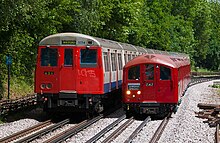Three-wire track system
The three-conductor track system is a construction of tracks for electric model railways that enables three-train operation . This was a system advantage advertised by the model railway manufacturer Trix in the 1950s over its competitors. A well-known slogan at that time was “always one more train with Trix”.
The special three-rail, three- conductor track system introduced by Trix Express in 1935 has three electrically isolated rails on a Bakelite track structure. This initially made it possible to run two trains independently of one another on one track without special switching ( two-train operation ). The current flowed from the middle rail to the right rail or, with the second train, from the middle rail to the left rail.
If an electrically functional overhead line was also used, even a third train could run independently - three-train operation was achieved. This was possible from 1951, when Trix Express brought out the first electric locomotive with functional pantographs. The current then flowed from the central rail to the overhead line.

The third rail in the middle position was already used for the large lanes 0 and 1 and also for the Bing 00 table track.
In Germany it was criticized from the mid-1950s as not being true to the original. However, in Great Britain, especially in the area of the London Metro , there are track systems with a third rail in the middle position and even with a fourth rail in the side position for the power supply.
In addition, some trams, especially French ones, use the APS system with power supply in the middle of the track.
In 1953 Trix Express introduced a new range of tracks. The three rails continued to consist of a sheet metal hollow profile, the threshold band was now punched out of cardboard. From 1964 "model 3-ladder tracks" were produced with corrosion-resistant full-profile rails made of nickel silver on plastic sleepers.
With Märklin's biggest competitor at the time , the track was made of sheet metal, and the two rails were electrically connected to one another. That is why you could only run one train over this track system and a second train with an additional overhead line. The other electric railways from this time (e.g. the Bing company ) also had an insulated central conductor that was touched by a slider, but rails that were electrically connected to one another.
The historical significance of the two or three-pass operation is that in the 1930s and 1950s no electronic circuits or even multi-frequency controls were available. Even relays were still very expensive and hardly affordable for model railroad fans. With the two- or three-train operation it was now possible to drive a second locomotive on a track already occupied by another locomotive, for example to pick up a through car there.
A disadvantage here is that locomotives without power supply via overhead lines run on a different circuit when the alignment is changed. With older models it would be necessary to swap the two external grinders so that they could continue to use the same circuit when turning around, with newer models with power consumption from the rails via the wheels, switching on the underside by hand. When driving without manual intervention, the advantage of multi-train operation on the corresponding track sections would be lost when using turntables (which were not originally produced for Trix Express) or turning loops, because the locomotive changes the circuit or the same circuit would be switched on both rails. However, this can be taken into account by sensible planning of the feeder sections and the pantograph alignment. In the case of locomotives for track use, for example, the external grinders should be arranged on the right-hand side, whereas in the case of shunting locomotives, on the left. In railway depots with turntables, their own power supply would be possible without using multiple trains.
With the takeover of the Trix company by the long-standing competitor Märklin in 1997, the production stop for the three-rail, three-conductor track system from Trix Express became apparent. While the product name "Trix H0" is still used for the two-rail direct current range from Märklin, accessories for the Trix Express program, in particular the three-rail, three-rail track system, have not been produced since 2003.
Some small manufacturers such as Mehano , Naumburg & Partner and others still offer individual vehicles, tracks and signals for the Trix Express system.
Despite the discontinuation of production by the Märklin company, Trix Express model railways are still being actively operated by model railroad fans and are increasingly being presented to the public at model railway exhibitions and other events. The long-term criticism of the “not prototypical” central conductor has turned into enthusiasm for a historical model railroad system, which comes into its own with accessories typical of the time from the 1930s and 1950s. The friends of this system are particularly widespread in Germany, the Netherlands and Great Britain.
In addition to Trix Express in West Germany, there were also two manufacturers of three-wire systems in East Germany, namely Pico Express (which then switched to two-wire systems under the name Piko ) and Primus from L. Herr KG . There were also ERGA three-conductor tracks from Ernst Ganzer , which were also sold by L. Herr KG.


